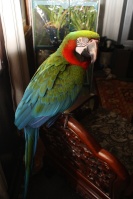Vikki
Scarlet Macaw

Join date : 2011-05-19
Age : 59
Location : BLAIRSTOWN NJ
My Birds : Sebastian - 7 yr old Harlequin Macaw
Arthur - 12 yr old Jardines Parrot
Pickle - 16 yr old Hahn's Macaw
Ecko - 26 yr old Hahn's Macaw
Plus the 180+ various bird from finch to Hyacinth at the rescue where I volunteer and live...
Posts : 811
 |  Subject: Harlequin Macaw Subject: Harlequin Macaw  Fri May 27, 2011 2:42 pm Fri May 27, 2011 2:42 pm | |
| Harlequin Macaw
Ara Ararauna / Ara chloroptera hybrid
A Harlequin Macaw is produced by crossing a Blue and Gold Macaw with a Green-Winged Macaw. Green-Winged Macaws originate in northern South America, ranging from Panama to Paraguay to Argentina. The Blue and Gold Macaw also originates from northern South America, covering almost the entire region.
It is reported that the coloring of the male parent will dominate the coloring of the offspring. Other reports state that the Harlequin will inherit the body type of the Green-Winged Macaw and the coloring of the female parent. The chest feathers of a Harlequin are often reddish-orange, edged with a brighter yellow-orange.
While the color of the Harlequin will be determined by the male parent, the temperament is generally a combination of the green-winged parent, which is docile, and the blue and gold parent, which is a natural comedian. The Harlequin will have the high level of intelligence inherent in all macaws.
Length: 34 - 36 inches
Weight: 2 – 4 lbs
Incubation: 26 - 29 days
Age at weaning: 12-14 weeks
Age at maturity: 2-4 years
Habitat: They are not found in the wild
Feeding: Macaws feed mainly on seeds, nuts, and fruits. With their powerful, vice-like bills, most macaws are able to crack open hard-shelled foods such as Brazil nuts. Their daily diet should include fresh fruits, vegetables and allowable table foods.
Suitability as pets: Macaws of the larger size require much more maintenance, experience and space than their smaller counterparts. With a wingspan of 41 – 49 inches, large macaws require a cage that is at least 4 feet wide and just as tall. Housing your macaw in a smaller cage will result in damaged or broken tail and wing feathers and the risk of added anxiety. Also unlike the smaller variety of parrots, macaws tend to flourish when not confined for long periods of time and do well to be left out to perch on a stand or tree as long as there are other companion birds or humans within eye contact. They are fluent speakers and average about 15- 20 words or phrases in their vocabulary.
Because of their beautiful coloring and often clown-like nature, many fail to appreciate the extremely intelligent nature of these beautiful macaws. With their large size and accompanying beak, they are prone to dominating any situation. Therefore, it is important for macaw owners to set the proper limits and boundaries as early as possible.
Lifespan: 65 – 90+ yrs
Sexing: DNA or surgical only. In some cases the males head will be more wide and flat as opposed to the female’s short, narrow forehead.
Misc Facts: Free flight speeds can reach up to 35 mph.
| |
|

